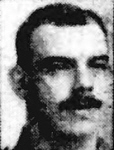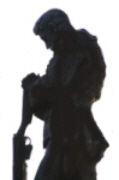



No.680572, Private, Frederick Morriss Harry LAMBERT
Aged 25

|
Born in 1892 (3rd qtr Bury St.Edmunds 4a:749) son of Frederick George and Kate LAMBERT(née BELSHAM)
< 1901 census...Aged 8, he was at 32 Long Brackland, Bury St.Edmunds with his father Frederick George LAMBERT [31] a tailor, born Ixworth; his mother Kate [28] ; sister Kate Augusta [6] and brother Arthur Leslie [4]. All except his father born in Bury St.Edmunds. 1911 census...Aged 18, an outfitter's light porter, he was at Alexander Cottages, Northgate Street, Bury St.Edmunds with his parents; brothers Arthur (errand boy), Herbert [7]and Edward [6]; sister Florence [9]. His mother had lost one of her 7 children. |

|
He enlisted in London The battalion were in the Bluff sector on 7th June and at 1 am they were served with tea and rum before attacking. 2:10 am the Battalion got into position to attack. ZERO 3:10 am There was a terrific shake of the earth caused by the explosion of mines under HILL 60, the CATERPILLAR and St.ELOI.The whole Bn at once moved forward and closely following the barrage the first wave quickly entered the enemy front line. A Coy on the right under Capt Hamilton nos. 4 and 2 platoons encountered practically no resistance only 2 or 3 |Germans being found who were taken prisoners. B Coy on the left under Capt H Cork Nos 5 and 6 platoons led by 2/Lt Phillips and 2/Lt King found several concrete dugouts at approx I.34.b.50.30 containing about 12 Germans who refused to come out when called on to surrender and had to be dealt with by moppers-up under Cpl Caney. This having been accomplished Cpl Caney and his party proceeded to mop-up the communication trench running from I.34.b.75.25 cutting IMPERIAL SUPPORT at I.35.c.1.9. In this trench further dug-outs were discovered containing enemy who were showing signs of resistance and were dealt with in a similar manner. In the meantime the 2nd and succeeding waves swept forward and occupied the second objective. On the right Nos.1 and 3 platoons of A Coy under 2/:Lt King met with considerable opposition.One piece of trench containing about 20 of the enemy held out for some time with machine guns, rifle fire and bombs. Several casualties were inflicted on our men before a well organised rifle bomb attack led by Sgt Shank+ caused the enemy to break and retire. A Lewis gun caught them before they had gone far and they returned to the original trench. After being attacked a second time with rifle bombs the enemy surrendered except 1 officer and 3 ORs who, attempting to escape were promptly shot. 1 officer and 15 ORs fell into our hands. On the left some dugouts at approx I.34.d.75.90 contained enemy and one which held was bombed, the occupants refusing to come out when called to surrender. This party was dealt with by 2/Lt Hayes and Pte Harrod. In this line about 40 of the enemy were killed, 1 officer and about 30 ORs were captured together with 2 machine guns, 1 trench mortar and a large quantity of bombs. Connection was at once established with the 24th Bn London Regt The Queens on our right and the 10th Bn Duke of Wellington's West Riding Regt 69th Brigade 23rd Division on our left. 2/Lt Francis, Bn Intelligence Officer having reconnoitred found a concrete dugout at I.34.d.70.80 where the Bn Command Post was immediately established under Capt Cork who took command of the forward companies. The troops of the 1st and 2nd waves were at once organised and the task of consolidation put in hand. The enemy trenches were found to b very much knocked about and in places entirely obliterated. The whole ground crossed was one mass of shell holes touching each other with the exception of No Mans Land which was in good condition and east to traverse. The enemy wire was found to be non existent While theses events were taking place the 3rd and 4th waves composed of C and B Coys under 2/Lt Barrow and Capt RR King respectively pressed on closely following the barrage. No 9 platoon under 2/Lt Wheeler established itself in the remains of the trench running NE and SW from O.4.b.85.70 to I.35.c.15.05, the remainder sweeping on to the 4th and final objective which was reached at the scheduled time viz Zero plus 47 minutes. After passing the 2nd objective very little opposition was encountered on the right until a dugout in the quarry at O.5.a.4.9.where 6 enemy resisted until the last were despatched. The left of the 4th wave met considerable machine gun fire from BATTLKE WOOD and several casualties were caused. D Coy reached their objective and found the trench from VERBRANDENMOLEN Rd for a distance of 100 yards was obliterated and kept under constant enemy machine gun fire so it was decided to set up a Lewis gun post only and occupy the rest of the trench, joining up on the left with C Coy The advance of the 3rd and 4th waves was very difficult owing the the condition of the ground, a mass of shell holes and no landmarks, Our artillery was very accurate, so good our men could keep within 30 yards of it and suffer no casualties. The enemy barrage was poor and had little effect. about 4 am a plane flew over and called for flares, which were lit by our most advanced line. Telephone lines were cut in the first moments and the signallers had to lay new ones. Visual signalling was impossible due to lack of observation and the smoke from shells. 6:50 am the 21st Bn went forward and took their 1st objective.Subsequent waves after rushing SPOILBANK were compelled to retire due to machine gun fire. They called for assistance and Capt Cork ordered 120 men from A and B Coys forward under Capt Hamilton.It was then decided it was not possible to proceed and they returned to their original positions. At the end of the day the 21st London line ran along OAF LANE joining our front. During the day there was slight enemy shelling but at 9:15 pm 21 Bn reported the enemy were massing for a counter attack and at the same time a heavy enemy barrage started. One of planes dropped a red flare to warn of impending enemy attack.Our artillery quickly opened fire and the counter attack failed to materialise. At 10:15 pm the situation was normal and remained so during the night. Bodies found and prisoner showed we were opposed by the 61st Regiment, 35th Division (Prussian) and the 2nd Battn 413 Regt, 204th Div. CWGC have 41 of the 22nd Bn killed that day, 19mof them with no known grave. From the various map referenes given and the location where Frederick was found he was killed early in the attack
click here to go to the Commonwealth War Graves Commission website for full cemetery/memorial details |